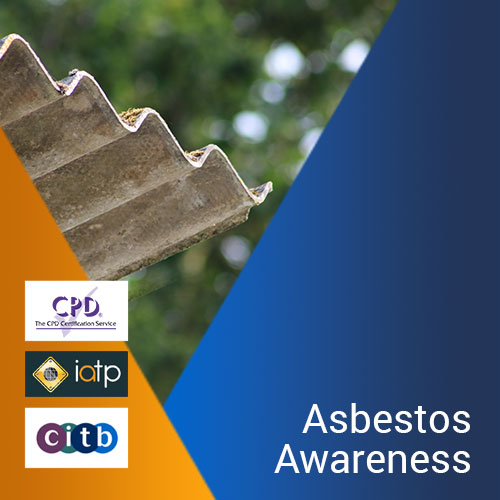South West England
- 01823 443898
Northern Ireland
- 02840 623566
Training Course
This course is designed for anyone who works within, maintains or refurbishes buildings built before the year 2000. Successful completion of this course will provide a level of awareness to reduce the risk posed by asbestos. This course does not provide any training on how to work on or remove asbestos.
The subjects areas covered are:
Price: £0!
Duration: ½ day, AM 9:00-12:30 (On Request PM 13:00-16:30)
Available: Online or Classroom
Maximum delegates: 12 per session
If you are looking for a discounted bulk booking of 8 or more delegates or for a private booking at your location, please enquire below.
£90.00 Original price was: £90.00.£0.00Current price is: £0.00. + VAT
The content of this course is designed to provide anyone whose work could foreseeably expose them to asbestos with sufficient knowledge to avoid putting themselves or others at risk, in line with regulatory requirements laid out in Control of Asbestos Regulations 2012.
The training will cover the topics in appropriate detail, by means of both written and oral presentation, and by demonstration as necessary.
A question and answer session will be held at the end of each module to ensure each learner has reached the necessary level of understanding.
Tutor assessment of learner performance during practical sessions with continual oral feedback.
A timed, invigilated, closed-book written examination will be individually completed by each learner at the end of the course, with 80% being the pass mark.
The end of course written paper will draw at least 15 short answer and multiple-choice questions from a module-based question bank, to include no less than two questions from each module.
Completed exam papers are retained by the course provider.
Written and / or Multiple Choice Assessment covering LO1-LO6
80% pass mark (pass / fail)
Maximum of 15:1
Face to face courses must take sufficient time to complete this syllabus; it is generally expected that 2 to 3 hours (excluding breaks) is acceptable.
This unit has six learning outcomes.
The learner should be able to:
Identify the properties of asbestos and outline the history of its use
Assessment criteria – The learner can:
a) Identify what the word asbestos refers to
b) List the common types of asbestos by colour, nature and name
c) Give a brief history of the use asbestos in the United Kingdom
d) State when the different asbestos types were banned from use within the UK
The learner should be able to:
Outline the health effects of asbestos
Assessment criteria – The learner can:
a)Identify why the properties of asbestos have such an adverse effect on health
b) Outline the reasons for the increasing numbers of asbestos-related deaths, including the latency period of asbestos-related diseases
c) State the primary cause of asbestos-related diseases
d) Identify those who are at the most risk from asbestos disease, including from secondary exposure
e) List the main types of asbestos-related disease and the parts of the body they effect
f) State why there is an increased risk of lung cancer for asbestos workers who smoke
The learner should be able to:
Outline the types, uses and likely occurrence of asbestos and asbestos containing materials (ACMs) in buildings and plant
Assessment criteria – The learner can:
a) State what is meant by ACMs and identify the difference between ‘asbestos’ and ‘ACMs’
b) List the types of asbestos and ACMs used in buildings, equipment, plant, etc and identify between which dates this use is most likely to have occurred
c) Identify the uses and likely occurrence of asbestos and ACMs in buildings, equipment, plant etc.
d) State what is meant by ’friability’ and identify the conditions under which various ACMs will release fibres
The learner should be able to:
Identify the main statutory provisions that relate to asbestos
Assessment criteria – The learner can:
a) Identify the main statutory provisions that protect people in the workplace
b) Identify the specific asbestos related statutory provisions
c) Identify the purpose of asbestos surveys and registers and list the information that they should contain
The learner should be able to:
Know the correct procedures to follow in an emergency
Assessment criteria – The learner can:
a) Outline what constitutes an asbestos emergency and how to recognise it
b) Identify the general procedures to be followed on an uncontrolled release of asbestos into the workplace
c) Identify the general procedures to be followed on damage to a suspect ACM
The learner should be able to:
Know how to avoid the risks of asbestos
Assessment criteria – The learner can:
a) Identify what asbestos risks you may be subject to in the course of your duties, for example building work

We are accredited / certificated for:
Our UKAS accreditation is limited to those activities described on our UKAS schedule of accreditation.
Click here to find out more about all our accreditations / certifications.